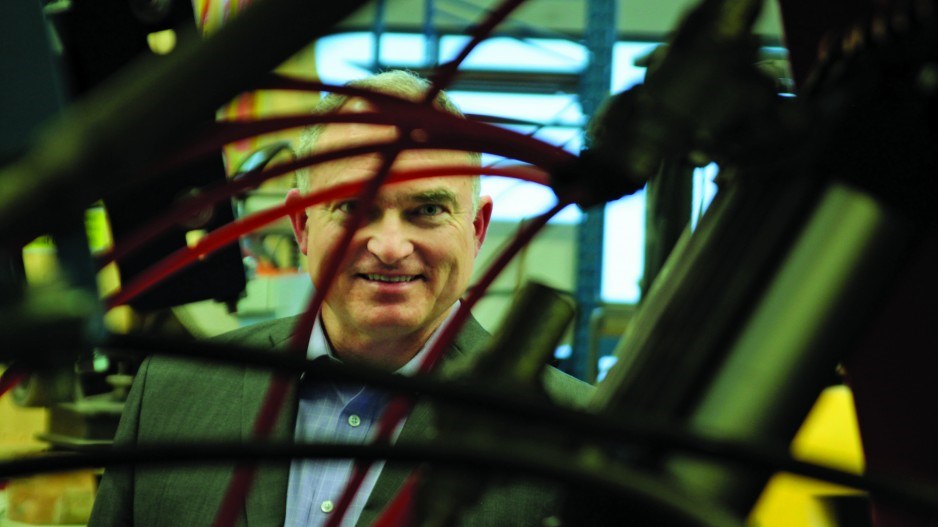But as mining and exploration companies look for ways to lower costs and improve efficiency, some are finding that investment in new technology has become imperative.
At the exploration end, Integra Gold Corp. (TSX-V:ICG), a Vancouver junior miner, plans to capitalize on a high-tech approach to identifying potential new mining targets on its Lamaque gold project in Val-d’Or, Quebec. Just last week it handed out $1 million in prizes in a crowdsourcing contest that drew teams of geologists and computer scientists from around the world to sort through 75 years of mining data from two old mines with the goal of pinpointing new exploration targets.
Meanwhile, Vancouver high-tech startup MineSense recently completed its first commercial pilot project to demonstrate that its sensor technology can improve the bottom line of a mine operation by $20 million to $200 million a year.
Another Vancouver high-tech company, Vandrico Inc., has married wearable technology and the industrial Internet of Things to develop a smartwatch that can be used in underground mines to produce a real-time, 3D situational map of its underground workforce.
“Innovation – a lot of people view it as an expense,” said Steve de Jong, Integra Gold’s 32-year-old CEO. “You have to spend millions of dollars on R&D.
“For us, this innovation exercise has been extremely accretive. We have to break this idea that innovation is just going to be a direct expense that might pay for itself years down the road.”
The exercise he refers to – a crowdsourcing approach to analyzing geological data – is a page taken from Goldcorp Inc. (TSX:G), which launched the Goldcorp Challenge in 2000. Goldcorp released data from its Red Lake mine in Ontario to the public in a competition to maximize the site’s potential.
The difference between the Goldcorp Challenge and the Integra Gold Rush Challenge is that geologists now have tools that weren’t available in 2000: cloud computing, machine learning, virtual reality, crowdsourcing platforms and social media.
Integra owns properties in Val-d’Or, which has a rich gold mining history. It is focusing its development efforts on one of several zones on its Lamaque property.
Integra had acquired the assets of two nearby historic mines that have been shut down for decades, including tailings facilities and a processing mill. But it also acquired 75 years of mining and exploration data – six terabytes’ worth (enough to, say, max out the storage in more than 20 new Apple laptop computers).
De Jong is confident there is still plenty of gold to be mined on the Lamaque property and believes there are hints about where to look buried in all that data.
The company could have put its own team of geologists to work analyzing the data to come up with new drilling programs, but it has its hands full trying to develop its Triangle zone.
“We don’t have time to go start digging through six terabytes of historical data to try and unlock the value and see if there are targets there,” de Jong said.
Like Goldcorp, Integra made all of its data public, launched a contest on the HeroX crowdsourcing platform and offered $1 million in prizes for the best exploration plan.
The company received more than 100 detailed submissions, shortlisted 20 and then convened a panel of independent technical experts to come up with five finalists.
On March 7, in a Dragons’ Den-style final pitch in Toronto, SGS Geostat was awarded a $500,000 grand prize. The remaining $500,000 went to other contestants in smaller prizes.
The SGS Geostat team included geologists and software engineers who used machine learning to sort through massive amounts of data and examine it using Oculus Rift virtual reality technology.
Although SGS Geostat won the grand prize, all of the other submissions are valuable, de Jong said.
“We look at the value of the work that we’ve had done on our project [through the competition] and it’s in the millions, because what we’ll do is take all these different submissions and compile that into one consistent exploration plan.”
By the time Integra puts a new mine into production, it will have some new high-tech tools at its disposal, like MineSense.
The company developed sensor technology and software that can be used to optimize sorting and processing to eliminate unnecessary processing of low-value ore. It can also be used to process mine waste to recover valuable metals that may have been missed.
It’s not just hardware that’s involved. MineSense also developed an industrial big-data solution that allows large amounts of data to be analyzed in real time.
“It’s a mining solution, but it’s very much an industrial IoT [Internet of Things], big-data, machine-learning technology,” said Jeff More, who was hired as MineSense’s CEO last year as part of the company’s commercial ramp-up.
The company recently completed its first commercial pilot project with a large, undisclosed mining company and has entered into agreements to conduct more pilot projects with a number of mines in Australia, the U.S. and Chile.
More said the recently completed pilot project demonstrates that there is a good return on investment.
“It ranges between $20 million and $200 million per mine per year,” More said.
More said the prolonged downturn in mining has made investing in technology that improves efficiencies an imperative for many companies, not a disincentive.
“Mines are much more focused now on finding solutions that will improve their bottom line,” he said. “ We’re finding the downturn to be a huge advantage to us.”




